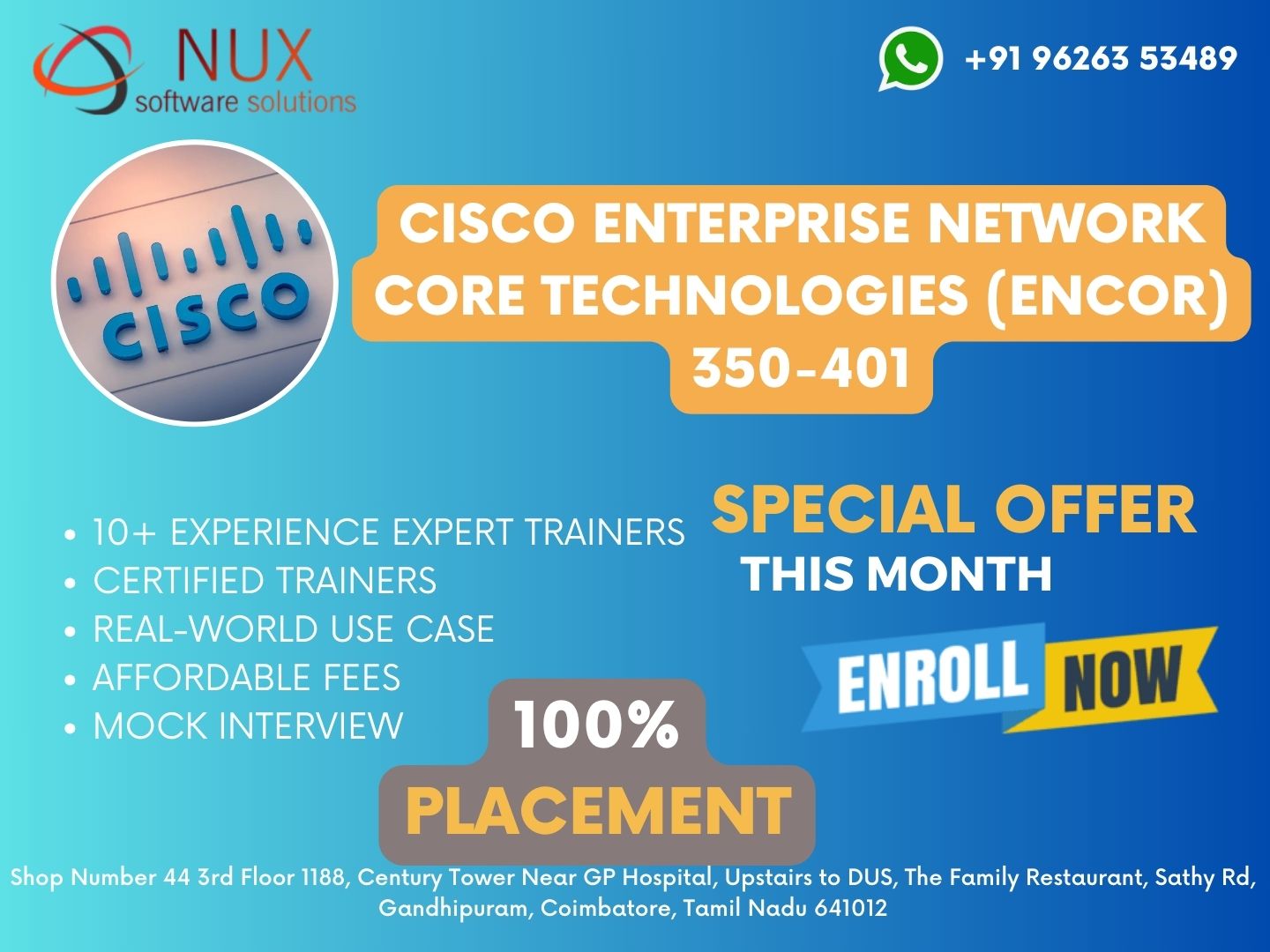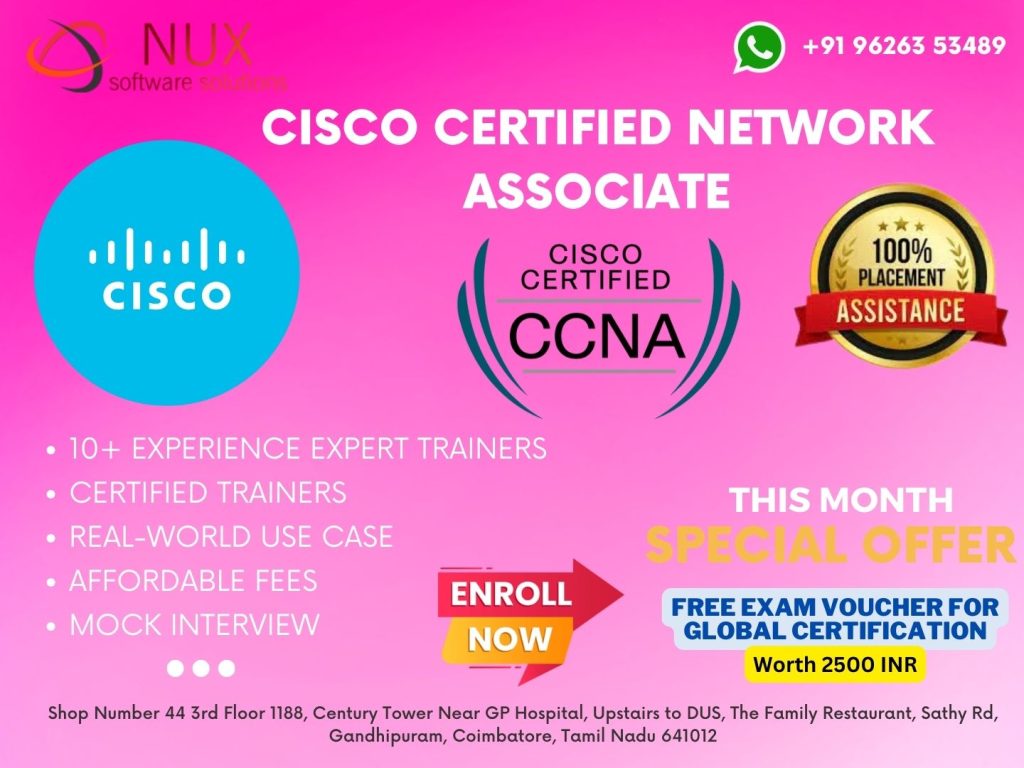Cisco Enterprise Network Core Technologies (ENCOR) 350-401 Training and Certification

Cisco ENCOR 350-401 Training and Certification in Coimbatore
Course Overview
The Cisco Enterprise Network Core Technologies (ENCOR 350-401) course is the foundational training for IT professionals pursuing Cisco’s prestigious CCNP Enterprise certification and also plays a significant role in preparing for CCIE Enterprise Infrastructure. This course equips learners with in-depth knowledge of enterprise-level networking, including dual-stack architecture (IPv4 and IPv6), virtualization, automation, security, and infrastructure.
At Linux Training Center in Coimbatore, our ENCOR training delivers real-world, hands-on expertise with Cisco devices and simulation tools, preparing you not only for the 350-401 exam but also for actual enterprise network environments.
Why Choose ENCOR 350-401?
As networks evolve into complex, cloud-driven, and automated systems, core enterprise networking skills are more important than ever. The ENCOR certification validates your ability to configure, operate, and troubleshoot complex routed and switched networks. It also serves as a core exam for other certifications, giving you flexibility in your Cisco career path.
This course prepares you to handle real-world responsibilities involving infrastructure design, wireless and security solutions, SD-WAN, and network automation.
Who Should Enroll?
This course is designed for:
-
Network Engineers and Administrators
-
System Engineers and IT Infrastructure Professionals
-
Cisco Certified Associates upgrading to CCNP
-
Professionals seeking advanced enterprise networking skills
-
Candidates preparing for CCNP Enterprise Core (ENCOR 350-401) or CCIE Infrastructure written exam
A CCNA-level understanding of networking fundamentals is recommended before enrolling.
What You Will Learn
-
Enterprise networking architecture and routing
-
Switching protocols and Layer 2/3 operations
-
Virtualization technologies in networking
-
Overlay technologies like SD-WAN and VPN
-
Network security principles and access control
-
Infrastructure services such as NTP, DHCP, and DNS
-
Wireless design and implementation basics
-
Automation with REST APIs, Python, and network programmability tools
-
Troubleshooting techniques for enterprise networks
The course is structured with real-time labs, command-line practices, and design discussions to ensure conceptual and hands-on clarity.
Course Highlights
-
Instructor-led training by Cisco-certified experts
-
Full coverage of the ENCOR 350-401 exam blueprint
-
Real-world enterprise network scenarios and case studies
-
Lab access to Cisco Packet Tracer and simulation tools
-
Flexible batch timings with online and offline options
-
Post-training support and CCNP exam preparation assistance
Career Opportunities
After completing the ENCOR course, learners can pursue roles such as Enterprise Network Engineer, Infrastructure Specialist, Security or Wireless Specialist, and Senior Systems Engineer. It also opens the path to specialization exams under CCNP Enterprise and the CCIE Enterprise Infrastructure certification.
Why Choose Linux Training Center in Coimbatore?
At Linux Training Center, we go beyond exam training. We focus on building job-ready skills, problem-solving capabilities, and deep technical understanding through expert-led sessions, hands-on labs, and career guidance. Our ENCOR 350-401 training ensures you’re prepared to thrive in today’s dynamic enterprise IT environments.
Cisco Enterprise Network Core Technologies (ENCOR) 350-401 Syllabus
Architecture – 15%
1. Explain the different design principles used in an enterprise network
Enterprise network design such as Tier 2, Tier 3, and Fabric Capacity planning
High availability techniques such as redundancy, FHRP, and SSO
2. Analyze design principles of a WLAN deployment
Wireless deployment models (centralized, distributed, controller-less, controller based, cloud, remote branch)
Location services in a WLAN design
3. Differentiate between on-premises and cloud infrastructure deployments
4. Explain the working principles of the Cisco SD-WAN solution
SD-WAN control and data planes elements
Traditional WAN and SD-WAN solutions
5. Explain the working principles of the Cisco SD-Access solution
SD-Access control and data planes elements
Traditional campus interoperating with SD-Access
6. Describe concepts of wired and wireless QoS
QoS components
QoS policy
7. Differentiate hardware and software switching mechanisms
Process and CEF
MAC address table and TCAM
FIB vs. RIB
Virtualization – 10%
1. Describe device virtualization technologies
Hypervisor type 1 and 2
Virtual machine
Virtual switching
2. Configure and verify data path virtualization technologies
VRF
GRE and IPsec tunneling
3. Describe network virtualization concepts
LISP
VXLAN
Infrastructure – 30%
1. Layer 2
- Troubleshoot static and dynamic 802.1q trunking protocols
Troubleshoot static and dynamic EtherChannels
Configure and verify common Spanning Tree Protocols (RSTP and MST)
2. Layer 3
-
Compare routing concepts of EIGRP and OSPF (advanced distance vector vs. linked state, load balancing, path selection, path operations, metrics)
Configure and verify simple OSPF environments, including multiple normal areas, summarization, and filtering (neighbor adjacency, point-to-point and broadcast network types, and passive interface)
Configure and verify eBGP between directly connected neighbors (best path selection algorithm and neighbor relationships)
3. Wireless
- Describe Layer 1 concepts, such as RF power, RSSI, SNR, interference noise, band and channels, and wireless client devices capabilities
Describe AP modes and antenna types
Describe access point discovery and join process (discovery algorithms, WLC selection process)
Describe the main principles and use cases for Layer 2 and Layer 3 roaming
Troubleshoot WLAN configuration and wireless client connectivity issues
4. IP Services
- Describe Network Time Protocol (NTP)
Configure and verify NAT/PAT
Configure first hop redundancy protocols, such as HSRP and VRRP
Describe multicast protocols, such as PIM and IGMP v2/v3
Network Assurance – 10%
1. Diagnose network problems using tools such as debugs, conditional debugs, trace route, ping, SNMP, and syslog
2. Configure and verify device monitoring using syslog for remote logging
3. Configure and verify NetFlow and Flexible NetFlow
4. Configure and verify SPAN/RSPAN/ERSPAN
5. Configure and verify IPSLA
6. Describe Cisco DNA Center workflows to apply network configuration, monitoring, and management
7. Configure and verify NETCONF and RESTCONF
Security – 20%
1. Configure and verify device access control
Lines and password protection
Authentication and authorization using AAA
2. Configure and verify infrastructure security features
ACLs
CoPP
3. Describe REST API security
4. Configure and verify wireless security features
EAP,
WebAuth,
PSK
5. Describe the components of network security design
Threat defense
Endpoint security
Next-generation firewall
TrustSec, MACsec
Network access control with 802.1X, MAB, and WebAuth
Automation – 15%
1. Interpret basic Python components and scripts
2. Construct valid JSON encoded file
3. Describe the high-level principles and benefits of a data modeling language, such as YANG
4. Describe APIs for Cisco DNA Center and vManage
5. Interpret REST API response codes and results in payload using Cisco DNA Center and RESTCONF
6. Construct EEM applet to automate configuration, troubleshooting, or data collection
7. Compare agent vs. agentless orchestration tools, such as Chef, Puppet, Ansible, and SaltStack



